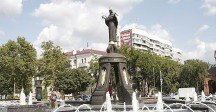Map of Yekaterinburg
Detailed interactive map of Yekaterinburg. Map of Yekaterinburg with streets and numbers of houses. Satellite map of Yekaterinburg with sights of the city.
The change between the satellite map of Yekaterinburg and the schematic one is made in the lower left corner of the interactive map.
Yekaterinburg
Population of the city Yekaterinburg: 1,495,066 people (2021)
Date of foundation of Yekaterinburg: November 18, 1723
Phone code of the city Yekaterinburg: +7 343
Automobile code of the city Yekaterinburg: 66, 96
The postal code of the city Yekaterinburg: 620xxx
Yekaterinburg (known as Sverdlovsk from 1924 to 1991) is located in West-Central Russia, on the eastern slope of the Ural Mountains. The city stretches along the valley of the Iset River, which was dammed, forming a number of small lakes and reservoirs.
It is the main city of the Sverdlovsk region, which is ranked fourth in the ranking of Russian cities in terms of population. Unofficially, it is considered the capital of the Urals. The Ural capital is also called a major transport hub, because it is located in the center of the intersection of major highways.
What to see in Yekaterinburg
Few buildings remain from the early days of the city. The oldest building, built in 1764, houses the Museum of Fine Arts. Several buildings in the classical style have been preserved, including the former merchant's palace on Voznesenskaya Hill.
The Cathedral on the Blood, opened in 2003, marks the place where Nicholas II, the last tsar of Russia, was executed in 1918. The leading cultural center of the Urals, Yekaterinburg has a large opera house and several theaters. There are also several higher educational institutions and a branch of the Russian Academy of Sciences.
The economy of Yekaterinburg
Yekaterinburg is a large industrial center specializing in heavy engineering industries. Yekaterinburg produces metallurgical and chemical equipment, turbines, diesels and ball bearings. The food industry is well developed. The city is located on the Trans-Siberian Railway and is a hub of several railway lines.
The history of Yekaterinburg
The city was founded in 1721, when an ironworks was founded here, and in 1723 the settlement was named Yekaterinburg in honor of Catherine I, the wife of Peter the Great. It grew as the center of the Ural Mountain region on the Great Siberian Highway after the 1780s and on the Trans-Siberian Railway a century later.
It is usually better to start exploring the city with a walk through the palace and park ensemble of the Rastorgev-Kharitonov estate, which is a creation of the 19th century. The Literary Quarter, which houses the city's best museums, is considered to be an equally famous place in the city.
Other interesting places in Yekaterinburg and structures are a television tower in the form of a chess piece, an ice town with ice sculptures and one of the largest water parks in the country.
Sights of Yekaterinburg
Ganina Pit, Monument to the keyboard, Sevastyanov House, Tsarsky Bridge, Black Tulip, Shartash stone tents, Yekaterinburg Circus, Devil's Hillfort, Kharitonovsky Garden, Historical Square, Ipatiev House, Yeltsin Center.
The largest cities in Russia:
2024 © Russia-Karta.ru







